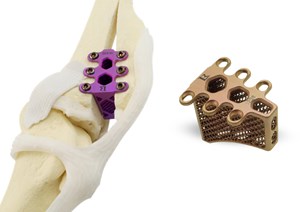
These titanium implants will have your best friend up and running again in no time. Courtesy of 3DS.
Latest News
March 11, 2015
Of all the uses either imagined or implanted for additive manufacturing (AM), improvements to medical technology shine the brightest. The opportunity to return patients to health is more valuable than any airplane jet engine or prototype. Nor are human patients the only ones to benefit from these advances.
Rita Leibinger Medical (RLM) has developed a line of titanium implants specifically designed for use in canine patients. The Tibial Tuberosity Advancement (TTA RAPID) series has brought improved mobility to over 10,000 dogs. Digitally designed and 3D printed, the titanium implants offer a robust solution to damaged cruciate ligaments, a common ailment for dogs.
 These titanium implants will have your best friend up and running again in no time. Image courtesy of 3D Systems.
These titanium implants will have your best friend up and running again in no time. Image courtesy of 3D Systems.“It is heartbreaking to see your dog in so much pain that he or she can barely walk,” said Rita Leibinger, owner and founder of Rita Leibinger Medical. “With this implant we experienced faster, more successful surgery and a faster recovery period. It is gratifying to see progress like this improve the lives of these animals and their families.”
Damage to cruciate ligaments can result from injury, genetics or simply as a result of advanced age. Traditional treatments often required multiple avenues of approach for successful rehabilitation, but the 3D-printed implants provide a treatment option without the necessity of repairing the damaged ligament through surgery.
In place of surgery on the ligament, the implant strengthens and realigns a dog’s lower leg, “…reorganizing the mechanical forces of the bones and creating dynamic knee stability without the need to repair the damaged ligament.”
The very nature of 3D printed objects is part of what has made the implants so successful. Any time titanium is selected as a material, costs have the potential to spiral beyond what is considered affordable. Because 3D printing is additive rather than subtractive, less material is wasted, resulting in lower costs.
The freedom of design offered by 3D printing also allows for the implants to have an open design that assist in promoting bone ingrowth. Additionally, each implant can be tailored for a specific patient with simple tweaks to existing designs. This is an important element when your patients range from Jack Russells to Great Danes.
Below you’ll find a video about the TTA RAPID series.
Source: 3D Systems
Subscribe to our FREE magazine, FREE email newsletters or both!
Latest News
About the Author
John NewmanJohn Newman is a Digital Engineering contributor who focuses on 3D printing. Contact him via [email protected] and read his posts on Rapid Ready Technology.
Follow DE





